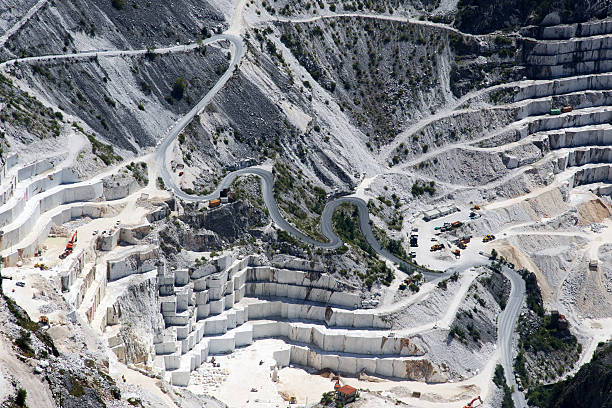Discover the Elegance Underneath: Granite Quarries in Rustenburg Revealed
Discover the Elegance Underneath: Granite Quarries in Rustenburg Revealed
Blog Article
From Quarry to Countertop: Understanding the Process of Granite Extraction
Granite, a prominent option for kitchen counters due to its longevity and aesthetic allure, undergoes an interesting journey from the midsts of a quarry to its final location in our bathroom and kitchens. As we dig right into the detailed process of granite removal, we will uncover the secrets behind the formation of these stunning stone down payments, discover the techniques and devices utilized in quarrying, and unwind the steps associated with transforming raw granite blocks into brightened and finished countertops. From the geological origins to the meticulous workmanship, this journey assures to expose the amazing tale behind the development of these functional and timeless pieces.
Formation of Granite Down Payments
The formation of granite deposits is a geologic process that includes the steady cooling and solidification of lava deep within the Planet's crust. Granite, an usual sort of igneous rock, is formed when molten lava cools down and solidifies over extended periods of time. This process occurs below the Earth's surface area, usually at midsts of several kilometers.
Granite is primarily composed of 3 main minerals: mica, feldspar, and quartz. These minerals integrate to give granite its particular texture and appearance. As the magma cools down, the minerals interlock and take shape, forming a securely packed framework. The sluggish air conditioning process enables the growth of big crystals, which offer granite its unique grainy texture.
The development of granite deposits is often related to structural activity, such as the collision of continental plates or the climb of magma from the mantle. The intense warm and pressure generated during these processes add to the melting of rocks and the subsequent formation of lava.
Over millions of years, the strengthened granite is exposed at the surface area through disintegration and uplift. This is when granite down payments can be quarried and removed for numerous applications, including counter tops, flooring, and building and construction materials.

Quarrying Methods and Devices
Quarrying techniques and tools play a critical role in the reliable extraction of granite down payments for various commercial applications. The procedure includes the use of specialized tools and equipment that make certain the secure and smooth removal of granite obstructs from the quarry website.
One of the primary techniques used in granite quarrying is drilling (granite quarries in rustenburg). This entails the use of boring devices equipped with diamond-tipped drill bits. These devices create holes in the rock surface area, permitting the insertion of eruptive costs. As soon as the costs are detonated, the resulting surge breaks the granite right into workable blocks.
In enhancement to exploration, cutting and splitting devices are likewise vital in granite quarrying. Cable saws and high-pressure water jets are typically used to puncture the granite. These techniques are reliable in dividing the granite into specific blocks, which can then be more refined.
Packing and carrying devices are critical in the transport of granite obstructs from the quarry to the processing facility. Sturdy trucks and forklifts are frequently made use of to relocate the blocks, guaranteeing their efficient and risk-free transfer.

Removal and Transportation of Granite Blocks
With the completion of the quarrying techniques and equipment section, we now transform our attention to the crucial procedure of drawing out and transporting granite blocks. As soon as the granite has been successfully quarried, it is necessary to remove the blocks from the quarry face. This is commonly done using hefty machinery, such as excavators or front-end loaders, which are outfitted with big blades or rippers to break the blocks devoid of the surrounding rock.
After the blocks have actually been extracted, they need to be moved to the processing center. This is usually done using specialized trucks or trailers that can carrying the enormous weight of the granite obstructs. These transport vehicles are made to make certain the reliable and risk-free movement of the blocks, with functions such as reinforced frameworks, hydraulic systems, and safe and secure tie-downs.
The transportation process requires mindful preparation and coordination to make sure the blocks reach their location without damages. This entails choosing the suitable routes, taking into consideration aspects such as roadway conditions, weight constraints, and the size of the blocks. It is also critical to secure the blocks properly during transport to protect against moving or moving, which could cause crashes or damages to the blocks.
Cutting and Forming Granite Pieces
To create refined and accurate granite slabs, a precise procedure of cutting and forming is used. As soon as the granite blocks have been removed from the quarry and delivered to the facility, they are all set to undertake this crucial action.
The edges of the slabs are smoothed and rounded, offering them an ended up and improved appearance. The surface of the slabs is additionally polished to achieve a glossy and reflective coating.

Polishing and Completing the Granite Countertops
The final action in the granite extraction procedure includes the precise sprucing up and completing of the granite kitchen counters. After the granite slabs have been cut and shaped to the preferred measurements, they go through a series of treatments to enhance their appearance and toughness.
The very first phase of the polishing process is referred to as grinding. During this stage, crude ruby abrasives are made use of to remove any flaws and smooth the surface of the granite. granite quarries in rustenburg. This process is essential for achieving an attire and level coating
As soon as the grinding is full, my website finer ruby abrasives are used to more fine-tune the surface area of the granite. This draws out the natural appeal of the stone and offers it a glossy and reflective look.
After the polishing phase, the granite countertops are thoroughly cleaned up to eliminate any kind of dirt or debris. This is followed by the application of a sealant, which helps secure the stone from spots and scrapes.
Final Thought
In final thought, the process of granite removal entails different stages, consisting of quarrying, removal, transport, reducing, shaping, brightening, and finishing. Granite down payments are developed over millions of years via geological procedures.
As we delve into the elaborate process of granite extraction, we will certainly discover the keys behind the development of these magnificent rock deposits, discover the techniques and tools employed in quarrying, and unravel the steps included in changing More Help raw granite obstructs right into polished and finished counter tops (granite quarries in rustenburg). These approaches are reliable in dividing the granite into private blocks, which can after that be additional refined
With the conclusion of the quarrying techniques and devices area, we now turn our attention to the essential process of carrying and drawing out granite blocks.To develop precise and refined granite slabs, a careful procedure of forming and cutting is employed.In final thought, the process of granite extraction entails various stages, consisting of quarrying, extraction, transportation, reducing, shaping, brightening, and ending up.
Report this page